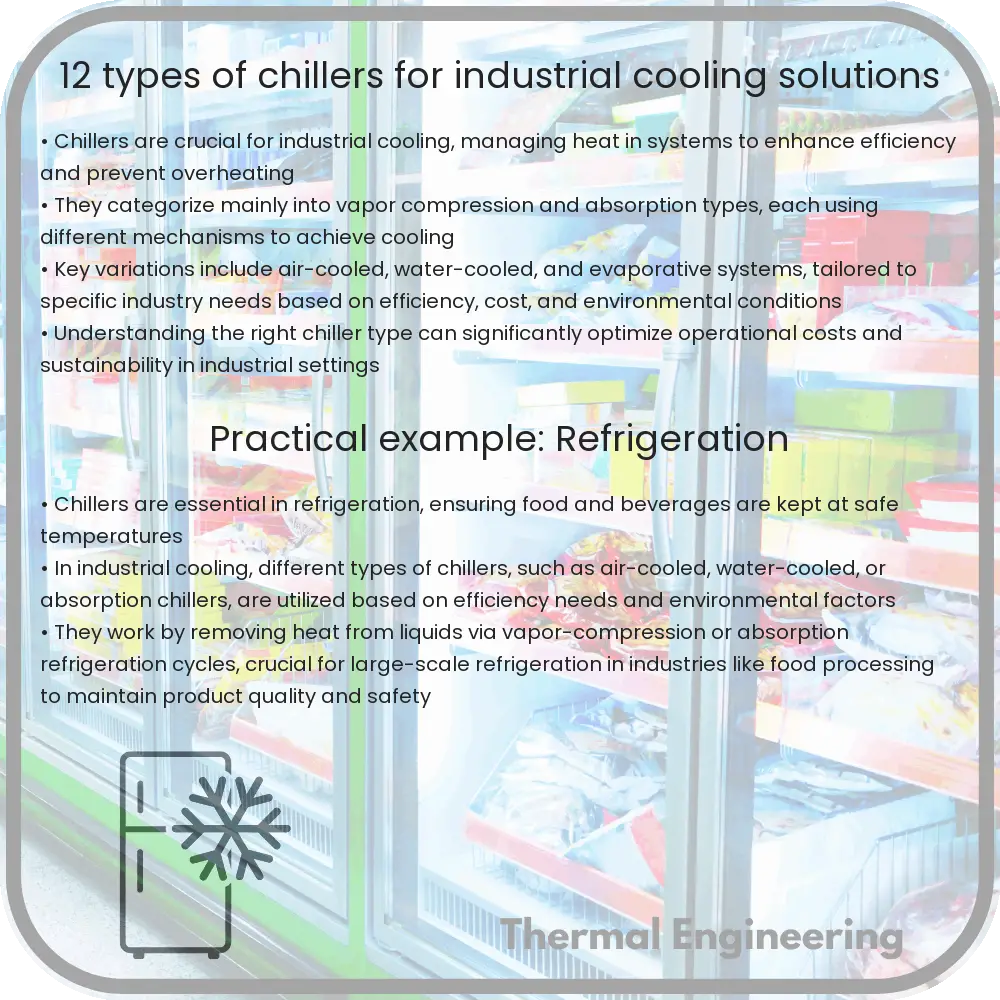This article provides an overview of 12 different types of chillers used in industrial cooling, explaining their functions, applications, and benefits.

12 Types of Chillers for Industrial Cooling Solutions
Chillers are critical components in the HVAC (Heating, Ventilation, and Air Conditioning) systems, especially within various industrial applications such as manufacturing, data centers, and commercial buildings. They help in removing heat from a liquid via a vapor-compression or absorption refrigeration cycle. This article explores 12 types of chillers, each suited for specific industrial cooling solutions.
Vapor Compression Chillers
Vapor compression chillers are the most common type, using mechanical energy to drive the refrigeration cycle.
- Air-Cooled Chillers: These chillers expel heat by passing the refrigerant through condenser coils and using fans to cool the coils. They are generally used in smaller or medium installations where space constraints exist.
- Water-Cooled Chillers: In water-cooled chillers, heat is expelled to a water line instead of the air. This type requires a cooling tower and is typically more efficient than air-cooled chillers, making them ideal for large industrial applications.
- Evaporative Condensed Chillers: These combine the features of air-cooled and water-cooled chillers. They use less water than traditional water-cooled systems by employing evaporative technology to enhance heat dissipation.
- Centrifugal Chillers: Utilizing a centrifugal impeller to compress the refrigerant, these chillers are suitable for large cooling applications and are known for their efficiency at high cooling capacities.
- Screw Chillers: Screw chillers use one or two helical rotors to compress the refrigerant. They are robust and can operate efficiently under varying conditions, suitable for both commercial and industrial settings.
- Scroll Chillers: These chillers employ one or two spiral scrolls to compress the coolant. Scroll chillers are known for their low noise, high efficiency, and reliability, suitable for medium-sized applications.
Absorption Chillers
Absorption chillers use heat as a source of energy to drive the refrigeration cycle, differentiating them from vapor compression chillers which use mechanical energy.
- Single-Effect Absorption Chillers: These use a single generator and are driven typically by low to medium temperature heat sources. They are less efficient than double-effect chillers but have lower operational costs.
- Double-Effect Absorption Chillers: Utilizing two generators, these chillers achieve higher efficiencies by using high-temperature heat sources.
- Triple-Effect Absorption Chillers: These are the most efficient among absorption chillers, employing three generators. They are complex and costly but offer the highest efficiency for large-scale industrial applications.
Specialty Chillers
These chillers are designed for specific applications that go beyond the general industrial or commercial cooling needs.
- Glycol Chillers: These use glycol mixed with water as the coolant, which provides anti-freeze properties ideal for subzero cooling applications.
- Reciprocating Chillers: These chillers use a piston-driven compressor, making them suitable for applications where high reliability and maintainability are crucial.
- Portable Chillers: Compact and moveable, these chillers can be utilized in applications where temporary or localized cooling is needed. They offer flexibility and convenience.
- Medical Chillers: These are precision chillers designed specifically to meet the stringent cooling requirements of medical devices and equipment.
Each type of chiller offers distinctive features and benefits, making them suitable for various industrial cooling applications. When choosing a chiller type, factors such as efficiency, cost, space, and specific cooling needs must be considered to ensure optimal performance and energy conservation.